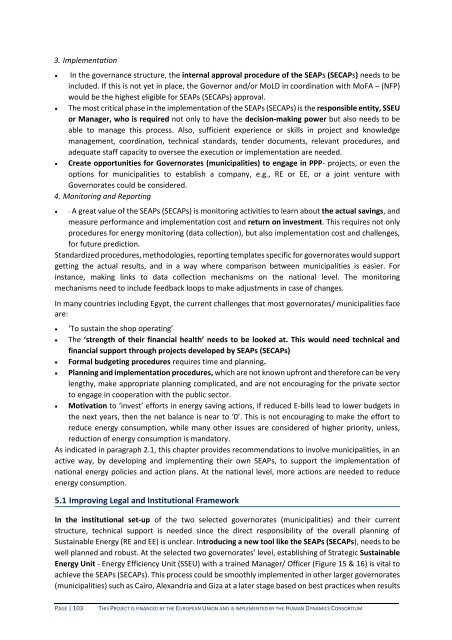180917_CES-MED_National_Report_Egypt_FINAL2rev
Create successful ePaper yourself
Turn your PDF publications into a flip-book with our unique Google optimized e-Paper software.
3. Implementation<br />
In the governance structure, the internal approval procedure of the SEAPs (SECAPs) needs to be<br />
included. If this is not yet in place, the Governor and/or MoLD in coordination with MoFA – (NFP)<br />
would be the highest eligible for SEAPs (SECAPs) approval.<br />
The most critical phase in the implementation of the SEAPs (SECAPs) is the responsible entity, SSEU<br />
or Manager, who is required not only to have the decision-making power but also needs to be<br />
able to manage this process. Also, sufficient experience or skills in project and knowledge<br />
management, coordination, technical standards, tender documents, relevant procedures, and<br />
adequate staff capacity to oversee the execution or implementation are needed.<br />
Create opportunities for Governorates (municipalities) to engage in PPP‐ projects, or even the<br />
options for municipalities to establish a company, e.g., RE or EE, or a joint venture with<br />
Governorates could be considered.<br />
4. Monitoring and <strong>Report</strong>ing<br />
‐ A great value of the SEAPs (SECAPs) is monitoring activities to learn about the actual savings, and<br />
measure performance and implementation cost and return on investment. This requires not only<br />
procedures for energy monitoring (data collection), but also implementation cost and challenges,<br />
for future prediction.<br />
Standardized procedures, methodologies, reporting templates specific for governorates would support<br />
getting the actual results, and in a way where comparison between municipalities is easier. For<br />
instance, making links to data collection mechanisms on the national level. The monitoring<br />
mechanisms need to include feedback loops to make adjustments in case of changes.<br />
In many countries including <strong>Egypt</strong>, the current challenges that most governorates/ municipalities face<br />
are:<br />
‘To sustain the shop operating’<br />
The ‘strength of their financial health’ needs to be looked at. This would need technical and<br />
financial support through projects developed by SEAPs (SECAPs)<br />
Formal budgeting procedures requires time and planning.<br />
Planning and implementation procedures, which are not known upfront and therefore can be very<br />
lengthy, make appropriate planning complicated, and are not encouraging for the private sector<br />
to engage in cooperation with the public sector.<br />
Motivation to ‘invest’ efforts in energy saving actions, if reduced E‐bills lead to lower budgets in<br />
the next years, then the net balance is near to ‘0’. This is not encouraging to make the effort to<br />
reduce energy consumption, while many other issues are considered of higher priority, unless,<br />
reduction of energy consumption is mandatory.<br />
As indicated in paragraph 2.1, this chapter provides recommendations to involve municipalities, in an<br />
active way, by developing and implementing their own SEAPs, to support the implementation of<br />
national energy policies and action plans. At the national level, more actions are needed to reduce<br />
energy consumption.<br />
5.1 Improving Legal and Institutional Framework<br />
In the institutional set‐up of the two selected governorates (municipalities) and their current<br />
structure, technical support is needed since the direct responsibility of the overall planning of<br />
Sustainable Energy (RE and EE) is unclear. Introducing a new tool like the SEAPs (SECAPs), needs to be<br />
well planned and robust. At the selected two governorates’ level, establishing of Strategic Sustainable<br />
Energy Unit - Energy Efficiency Unit (SSEU) with a trained Manager/ Officer (Figure 15 & 16) is vital to<br />
achieve the SEAPs (SECAPs). This process could be smoothly implemented in other larger governorates<br />
(municipalities) such as Cairo, Alexandria and Giza at a later stage based on best practices when results<br />
PAGE | 103<br />
THIS PROJECT IS FINANCED BY THE EUROPEAN UNION AND IS IMPLEMENTED BY THE HUMAN DYNAMICS CONSORTIUM

















